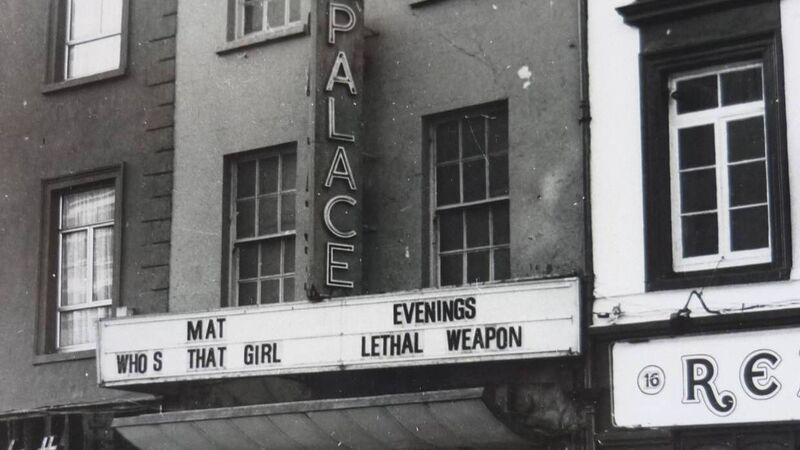Nostalgia: A musical hall where staff were a big family

Palace Cinema main entrance in 1988.




Palace Cinema main entrance in 1988. Picture courtesy of Richard T. Cooke
IN March 1988, Barry Leahy, the well-known film operator at the Palace Cinema for over 30 years, invited me to this Cork establishment on McCurtain Street – it was closing down and he wanted to chat with me about its history.
Off I went and met Barry who introduced me to the manager, Anne Broderick; the head usher, Patrick O’Lonaigh and the shop manager, Sandra Brennan, after which Barry and I took to our seats in the theatre. Surrounded by royal plush Victorian elegance, we chatted about its rich colourful heritage.
The following June, after serving the people of Cork for almost a century, its doors closed; two years later it was taken over by the Everyman Theatre Co and subsequently became known as the Everyman Palace Theatre.
The Palace Cinema had been known as “The Palace of Variety” or “Dan Lowrey’s Musical Hall” and was the oldest purpose-built theatre building in Cork, opening its doors to the public on Easter Monday night, April 19, 1897.

Dan Lowery owned theatres in Belfast and Dublin and had taken a great gamble in opening a musical hall in Cork in that the part of town where it was located was off the beaten track.
The building extended from McCurtain Street to St Patrick’s Quay where vessels from foreign parts docked outside its back door stage. Adjacent to it were ramshackle sheds, store houses, coal sheds, and a disused quarry – a haunt for idlers and layabouts. In addition, not only were the locals all fierce theatrical critics; the influence of the clergy on public opinion at the time was immense, adding further scrutiny to Lowrey’s venture.
Despite all the odds however, The Cork Examiner tells us that Lowrey’s Musical Hall had a brilliant opening night.
The place was thronged with people from all walks of life eager to see the show. One can imagine the excitement – the sound of the orchestra members busily tuning their instruments, the performers trying to keep their stage fright in check, stage hands hurrying to and fro – a veritable hive of activity. Dan Lowery, dressed in Victorian elegance, could be seen wiping his brow with a silk handkerchief as he peeped out through the curtains onto the tobacco smoke-filled hall.
Seated up in the “gods”, soaking up the atmosphere, were the “critics”, turning their attention now and then to the enthusiastic audience seated below. And with every appearance of a well-known public figure, choruses of cheers, whistles and hisses filled the air, adding to the excitement.

The highlights of the bill that night included the Australian FT Millis, ventriloquising his dolls with Corkonian drolleries and chorus girls who concluded the show amidst rousing cheers and song. That night Dan Lowrey was accepted by Corkonians.
During that time, everyone went to church and no decent lady would be caught dead in a musical hall due to their rather dubious reputation. Despite this and in order to attract a female audience, Lowrey instituted a ladies’ night where each lady was presented with a cup of tea on a tray during the interval. Because of this, Lowrey’s Hall soon became known as a reputable institution.
During the early years of the 20th century, Thomas F O’Brien, an opera lover, became the new manager and soon the Palace became a noted venue for operas. In 1918, it had a staff of 50, which included six orchestral musicians.
In December 1955, when the Opera House burned down, the Palace put on all their plays and operas. The following year, Mr Ahern, the Palace manager died and Dermot Breen took over his position. And in 1959, due to the increase in film goers, the Palace closed for a few weeks for renovations, reopening on Saturday night, December 12. According to Barry Leahy: “It was a night to remember. Outside on MacCurtain Street there were hundreds and hundreds of people of all ages, all eager to get a glimpse of some of the well-known personalities as they entered. Our own Jack Lynch – then Minister for Industry and Commerce – officiated at the opening.”

The Palace was an MGM house and was the first cinema in the city to install “cinemascope” and “perspecta sound”. Whenever a good film came on the market, the Palace booked it.
And when the films arrived at Kent Station, they were brought by horse and cart to the Palace.
During a screening of the film Ben Hur in the early 60s Leahy recalls: “One night there was a violent storm; the picture kept going on and off, but it stayed on for the entire chariot race which ran for 20 minutes; however, after the showing many in the audience became a little hot under the collar and demanded a refund. However, Mr Breen was on the spot and explained that it had been out of our control. This was accepted and everybody went home.”
During the 60s, magic shows were very popular. Paul Goldin and “Mandrake” always attracted a full house, however, with the advent of TV in the early 60s and videos in the 70s, many of the city’s major cinemas were closed.
Recalling the closure of the Palace Cinema, Leahy said: “Looking back over the years at the Palace, we were all one big happy family. We had our ups and downs, but who hasn’t. I enjoyed working there very much.”
Keep up-to-date with the top stories in Cork with our daily newsletter straight to your inbox.
Please click here for our privacy statement.
Have you downloaded your FREE  App?
App?

It's all about Cork!
Add Echolive.ie to your home screen - easy access to Cork news, views, sport and more